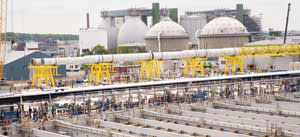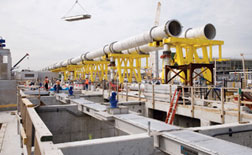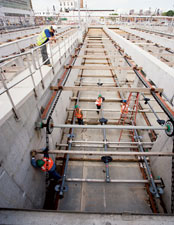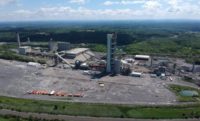 |
| Challenging. Tight site squeezes in old and new digesters and new final sedimentation tanks. |
Brooklyn’s gritty industrial waterfront is bristling with frenetic activity as engineers and workers jockey about a tight site upgrading New York City’s largest wastewater treatment plant. The mammoth project, costing more than $3 billion, will process 310 million gallons of wastewater per day to federal secondary treatment standards by late 2007 and give neighbors much needed odor relief and community amenities.
Since 1998, 800 to 1,000 workers from 25 prime contractors and hundreds of subcontractors have labored intensively on the 53-acre site to overhaul the treatment plant. The work list includes a new battery of grit chambers, aerators, final sedimentation tanks, a biosolids dewatering complex and a disinfection facility. At the same time, others are reconstructing the existing two batteries and replacing conventional digesters with larger volume egg-shaped digesters, all while keeping the plant fully operational.
The project, mandated by the Federal Water Pollution Control Act of 1972 and a subsequent consent order, also involves dismantling an old petroleum tank farm and placing or replacing structures in a challenging three-phase sequence.
 Click here to view chart
Click here to view chart
 |
| Viewpoint. Eight egg-shaped sludge digestion tanks dominate the Newtown Creek site. |
The Newtown Creek Water Pollution Control Plant, built in 1967, is the largest of 14 city treatment plants and takes in flows from sections of Brooklyn, Queens and one-third of Manhattan. It utilizes a modified activated sludge process. Currently inflow moves through screens into grit chambers then on to aeration and settling tanks, before chlorination and discharge into the East River. Screenings, grit and floatables are sent to landfills. Sludge is piped to thickening and digestion tanks and barged offsite for final treatment.
To meet new demands, the site footprint had to be nearly doubled through land takings. Early estimates placed the total cost at $2.8 billion but time and materials changes will easily bump the number over $3 billion.
The upgrade is dubbed “Track Three” because it is the third option considered by the city’s Dept. of Environmental Protection. The plan—providing secondary treatment without the use of primary settling tanks—saved a whopping $1 billion.
“We did a series of pilots and used [biofiltration] for polishing but it did not show promise,” says Alfonso R. Lopez, DEP deputy commissioner. “Track three is an enhancement of the existing system with more final settling tanks, more aeration volume but without primary tanks. It’s different but it is economical since the cost to build primary tanks was about $1 billion in 2000.”
 |
| Pynn |
Track one was a conventional plant with primary tanks and additional nitrogen removal primarily through longer retention time. “We use detritors in lieu of primary tanks as roughing filters in order to protect the aerators from the inorganic grit load,” says James P. Pynn, plant chief. “It saved money on land taking and construction.” The money saved will be used to defray capital costs of a citywide denitrification program.
To date about $1.7 billion has been awarded or completed. Still to be let are influent and screening modifications to the main building, estimated at $158 million, constructing new central residuals facilities for $260 million, the $150-million south central battery upgrade, the $454-million south battery upgrade and new barging facilities, for $58 million. Dates have not been announced but construction could start in 2008 and 2009 for a targeted 2013 completion. The additional construction, with the possible exception of the south central battery, is not critical for compliance with the amended Clean Water Act but is intended to provide redundancy and increased reliability.
To deliver the job DEP tapped the joint venture of Chicago-based Greeley and Hansen, Hazen and Sawyer PC, New York City, and Malcolm Pirnie Inc., White Plains, N.Y., as design consultant in 1995. Hazen and Sawyer and Malcolm Pirnie teamed as agency construction manager in 1998. Because of the state’s Wicks Law, the project utilizes multiple primes as general, mechanical, plumbing and electrical contractors.
“Greeley and Hansen actually started working on an upgrade plan in 1978,” says Steve A. Gyory, design joint venture project director. “But as the project grew in size and complexity it needed the resources of three firms.” The JV had to devise a multiple track plan to allow the upgrade to move forward while maintaining operations. Each track contained common secondary treatment elements.
Nitrogen removal complicated things. New York City is under a reduction order because of hypoxia problems in Long Island Sound. The East River empties into the western end of the 110-mile long sound. Four upper East River plants discharge about 482 mgd into the river, causing an estimated 50% of the sound’s nitrogen load. Newtown Creek contributes effluent and also ships its sludge to those plants. Also, during wet weather, combined storm flows at Newtown Creek can more than double capacity. When the flow reaches 620 mgd, effluent is released untreated through 54 outlets into the East and Hudson rivers. That threshold will rise to 700 mgd around 2010.
 |
| Bridging. Odor control and process air piping spanning aerators required extensive support. |
Nitrogen and wet weather aren’t the only problems. The 3.5-mile-long Newtown Creek is considered one of the most polluted waters in the U.S. Before flowing into the East River it runs adjacent to 12 hazardous waste sites, one containing a large 17-million-gallon oil plume. All soil on the project’s appropriated property is petroleum contaminated, although not connected to the plume. More than 1 million cu yd of contaminated soil has already been removed and shipped to licensed facilities. Another 200,000 cu yd may still follow.
 |
| Air. Diffusers will aerate secondary flows. |
“We incorporated water-tight sheeting around the deep excavation sites to prevent migration of the plume toward the plant and installed monitoring wells to check the groundwater table,” says Gyory. About 60 wells are monitored weekly and show no sign of migration.
Major construction started in 2000. To date 24 of 48 reinforced-concrete detritors are under construction. Each is 26 x 25 x 10 ft with one-third of them allocated to each battery. Six of the 12 reinforced-concrete aeration tanks, each with four passes measuring 26 x 200 x 15 ft, are under construction, as are 12 of 24, 397 x 56 x 13-ft sloped reinforced-concrete sedimentation tanks. A disinfection facility is being expanded. Aeration tanks will be fitted with aluminum covers to contain odors. A 96-in.-dia pipe will move air from the tanks to a process gallery with 14-ft-dia fiberglass carbon absorbers.
Because of site space issues, gravity sludge thickeners are being replaced with 24 centrifuge thickener machines located in one building, now under construction. Eight, 3-million-gallon carbon steel egg-shaped digesters are being built along with two, 2.4-million-gallon steel sludge storage tanks. The anaerobic digesters sit on a 9-ft-thick reinforced concrete foundation mat that required removal of 35 ft of overburden. One worker died during erection of a tower crane on the digester project.
Not yet under construction are ten 3⁄8-in. climber-type bar screens to be located before the detritors. The finer screens are needed because there are no primary tanks.
The existing 4,800-ft-long, 12-ft-dia outfall pipe was inspected and reconnected to three new chlorine contact tanks, providing a minimum of 15-minutes contact time before discharge.
 |
| Marra |
“Our biggest challenge was coordinating 20 primes while maintaining around-the-clock plant operations,” says Carmine A. Marra, construction manager for the Hazen and Sawyer/Malcolm Pirnie joint venture. “Coordination is key because at any given time contractor or plant operations could be impacted by a road closing or equipment deliveries.”
The joint venture of Slattery Skanska, John P. Picone Inc., James McCullagh Construction and Perini Corp. (SPMP) is general contractor for the new north battery and some central battery renovations totaling $493 million. Work began in September 2003 and is scheduled to end in February 2008. It includes building 16 new detritors, four aeration tanks, eight sedimentation tanks and a large two-story control structure on a 410 x 450-ft footprint. The JV also will recondition four central battery sedimentation tanks and build a new influent distribution system comprised of an uptake shaft, conduit and 2,400 sq ft reinforced concrete splitter box.
“The splitter box takes four, 96-in.-dia concrete-encased steel pipes, located 30 ft below grade, and sends influent equally into 12, 60-in.-dia pipes to the grit chambers,” says SPMP project manager Larry M. Gillman. “To bring Manhattan sewage into the box we had to drill through 36-in. reinforced-concrete into a 10-ft-dia influent shaft and retrieve the core.”
To do that, SPMP developed a 30-ft-tall custom drill rig to punch concentric 14-in. and 60-in. holes and then catch a 12,000-lb core. Workers then drilled out to 96 in. and caught that core using a special assembly mounted on the inside of the bit, he says.
SPMP also is supplying nine, 2,000-hp air blowers and an 8-ft-dia overhead distribution system running above the aerators. “We had to go down into the existing tanks and drill mini piles, build reinforced foundations, steel support towers and then place the steel pipe, some in 200-ft spans,” says Gillman.
Coordination and technology also figure in project management. The CM uses a cost-and-resource loaded CPM schedule to manage men, material and payments. All documents, including reports, change orders, RFIs and schedules are digitally scanned and published to a website for team accessibility and to save routing time. Three web cams take site pictures every 15 minutes to create a pictorial history. “These are all new to the city and will probably become commonplace in the near future,” says Marra.
 |
| Fitting Out. Solids handling equipment is placed into tanks. |
The Newtown Creek Monitoring Committee, a neighborhood group formed in the late 1990s, is helping to oversee construction. “This plant has never been upgraded to secondary treatment and the bad odors were unbelievable,” says Christine H. Holowacz, committee liaison. “Now, since construction, we have a lot of traffic, dust and parking problems.”
She says the neighborhood has received several amenities from DEP including a plant perimeter nature walk and on-site visitors center with a fountain and pocket park. But the group is now worried about a new neighbor, an asphalt plant that could adversely impact the nature walk. “We are negotiating with DEP to do some air quality monitoring to make sure the walk is safe,” she says.
Maureen Wren, assistant commissioner of the New York State Dept. of Environmental Conservation, says the department is continually monitoring progress to ensure compliance. “The city has missed three interim milestones,” she says. “But DEC is committed to...the 2008 and 2013 [completion] dates.” Failure to meet major milestones could trigger substantial financial penalties.
If the new system fails testing, to be conducted in 2008, additional treatment would have to be installed. That would probably mean installation of a traditional primary treatment process. Additional land taking may also be required. “We did some demo testing through 2005 and it increased our comfort level,” says James G. Mueller, DEP director of planning & design. “We are having ongoing discussions with the state on this issue.” Discussions include the missed interim milestones, which were based on rejected high bids, and possible means of accelerating construction.
“That will include repackaging contracts into smaller packages in order to increase competition and sharing cost escalation risks with contractors,” says Lopez. Whatever the outcome, “this is a once in a lifetime project,” says Marra.
(Photos by Michael Goodman for ENR)



Post a comment to this article
Report Abusive Comment